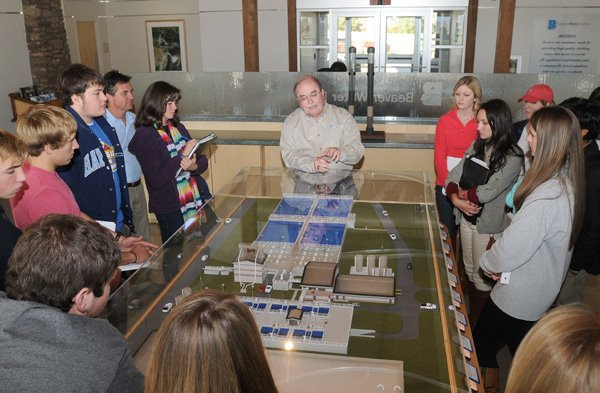LOWELL — Water is a precious resource, said Alan Fortenberry, addressing a group of high school students who visited the Beaver Water District’s headquarters Wednesday.
“God only made so much water, and it’s constantly getting recycled,” said Fortenberry, the district’s chief executive officer.
About 70 Advanced Placement environmental science students from Springdale and Har-Ber high schools spent two hours at the district’s office learning about the origin of their drinking water and the various ways the district tries to minimize its impact on the environment.
At A Glance
Beaver Water District
Beaver Water District was established in 1959. It supplies water to more than 300,000 people and industries in Northwest Arkansas. The district is run by an elected board of six.
The Water Education Center, at the district’s administration center, 301 N. Primrose Road, Lowell, features a large watershed map, a scaled plant model and other educational features, including interactive kiosks with lessons on the process of purifying water from Beaver Lake. The center is open from 8 a.m. to 4:30 p.m. Monday through Friday.
School groups may schedule a visit by contacting Amy Wilson at 479-756-3651.
Source: Staff Report
The district’s 14,000-square-foot administration center meets Leadership in Energy and Environmental Design standards at the gold level, one step below the highest level of platinum. The U.S. Green Building Council sets those standards.
Three groups of students rotated through presentations made by Fortenberry and other district officials.
Bill HagenBurger, plant engineer, guided students through some of the outdoor features meant to limit effects of rainwater runoff.
He explained traditional construction techniques have emphasized moving water off and away from a structure as quickly as possible. That raises the speed at which water flows into the watershed, which increases the rate of erosion and therefore the amount of pollution in the water.
HagenBurger explained how the pervious, or porous, pavement in the parking lot outside the district’s administration center captures rainwater, allowing it to seep slowly into the ground below while at the same time filtering pollutants.
Dot Neely, district education coordinator, pointed out a simple bio-retention ditch near the road. The ditch is lined with buffalo grass, which slows rainwater.
“We have several features that slow, spread and soak the water that comes in,” Neely told students.
HagenBurger discussed the district’s geothermal heating basins. Those help regulate the temperature inside the building.
“In summer, we take heat out of the building and put it in the ground,” he said. “In winter, we take heat out of the ground and put it in the building.”
Lynn Nokes, the AP environmental science teacher at Har-Ber, said seeing real-world applications of the subject matter is education at its highest level.
“It’s a tremendous enhancement of the curriculum,” Nokes said.
Earlier in the day, the students visited Eco-Vista Landfill near Tontitown then went to J.B. Hunt Park where they learned about the wind turbine installed there. That turbine is also equipped with solar panels that move to track the sun.
This is Nokes’ third year teaching AP environmental science.
“It’s a field that’s broadening very rapidly,” he said, noting the University of Arkansas has developed two degree programs related to it and John Brown University just established an environmental degree.
Companies such as Walmart are becoming more environmentally conscious, developing strategies related to sustainability, he said.
Brittany Wilson, one of the Har-Ber students, said she wants to work in agriculture after she graduates. She was impressed by Beaver Water District’s facility and the efficiency measures officials have taken.
“I didn’t realize the process of treating the water took that much scientific knowledge,” Wilson said. “I didn’t realize it was that complex.”
Fortenberry told students about different jobs required at the district, which employs 52. He said the district tries to remain competitive in the salaries it pays.
Across the country, he said, finding the engineers and other workers to fill utility jobs is a challenge.
“It’s not just aging infrastructure you have to replace, it’s aging workers,” Fortenberry said.

